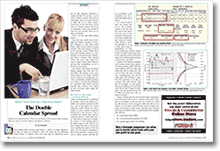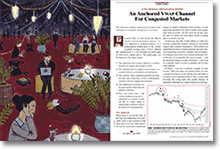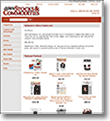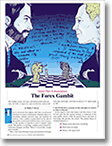Letters To The Editor
September 2010 Letters To The Editor
The editors of S&C invite readers to submit their opinions and information on subjects relating to technical analysis and this magazine. This column is our means of communication with our readers. Is there something you would like to know more (or less) about? Tell us about it. Without a source of new ideas and subjects coming from our readers, this magazine would not exist.
Address your correspondence to: Editor, Stocks & Commodities, 4757 California Ave. SW, Seattle, WA 98116-4499, or E-mail to editor@traders.com. All letters become the property of Technical Analysis, Inc. Letter-writers must include their full name and address for verification. Letters may be edited for length or clarity. The opinions expressed in this column do not necessarily represent those of the magazine. —Editor
CALENDAR SPREADS
 Editor,
Editor,
Perhaps in a sequel to “The Double Calendar Spread” (Stocks & Commodities, July 2010), author Jay Kaeppel might compare the double calendar to the iron condor. I’ve had limited success predicting the outcome of calendar spreads, primarily because their risk curves do not accurately reflect the spread’s value as the near-term option approaches expiration. With their “sag in the middle,” the risk curves for the double calendar seem to be far more uncertain than the “plateau-like” risk curves of the iron condor, whose risk/reward is comparable to the double calendar.
Incidentally, Kaeppel’s book, The Option Trader’s Guide To Probability, Volatility, And Timing, has an excellent chapter on calendar spreads.
—Chris Pflum
Las Vegas, NV
Jay Kaeppel replies:
The primary difference between a double calendar and an iron condor is the circumstance in which they should be utilized.
In a high-volatility environment, the iron condor is generally preferable because: a) it allows the trader to take in the most premium, and b) a double calendar spread is susceptible to a “volatility crush” if volatility falls after the trade is entered. When entering a double calendar, the trader ideally wants implied volatility to either rise or at least remain relatively unchanged.
For any calendar spread — double or otherwise — a rise in implied volatility will shift the risk curves “higher” (that is, farther in a positive direction), while a decline in implied volatility will push the risk curves farther into negative territory.
In sum, if implied volatility is extremely high, favor the iron condor. Under any other circumstance (and as long as you have some reason to think the implied volatility will not fall sharply), a double calendar is a strategy worth considering.
Hope this helps.
VWAP CODE FOR REAL TICK?
 Editor,
Editor,
As an avid reader of your magazine, I particularly enjoyed the article by Andrew Coles in the July 2010 issue, “An Anchored Vwap For Congested Markets.” In the Traders’ Tip section of that issue, you give the code for various trading platforms, but unfortunately, not the one that I use for my stock trading.
Do you or does someone else there have the code equivalent for us RealTick users?
—Ray
Toronto, Canada
Unfortunately, we are not able to provide the code. You might try the RealTick technical support forum or user forum, or try requesting the code equivalent directly from RealTick technical support.
Alternatively, you could try posting your request for RealTick code at a general forum for traders or technical analysts, or use a private programming service for your particular needs (some are listed in our magazine’s classifieds section and also at the Traders’ Resource database at our website, www.traders.com, under the “Consultants”category).
—Editor
ARTICLES ONLINE?
Editor,
Is it possible to retrieve articles from past issues of S&C via the web?
—John Dueweke
 Yes. You can purchase individual past articles from the Online Store at our website at https://store.traders.com/. You can use the search feature there to help locate articles.
Yes. You can purchase individual past articles from the Online Store at our website at https://store.traders.com/. You can use the search feature there to help locate articles.
You can also access some of our regular features and departments from past issues for free at our website. Visit our back-issue archive (https://www.traders.com/Documentation/FEEDbk_docs/backissues.html) to browse past tables of contents.
Another alternative is to purchase our S&C On DVD if you have a need for many of our past articles, since one price gives you access to 27 years’ worth of articles.
Thank you for writing.
THE FOREX GAMBIT
 Editor,
Editor,
Thank you to author Walter Downs for an excellent article in the June 2010 issue (“The Forex Gambit”). When I saw that he had an advanced education in esoteric mathematics I was afraid I would be lost within two sentences. On the contrary, his article is one of the most clearly written and understandable articles about any kind of technical analysis I have read in the past 15 months of daily study.
—Leroy Cook
Ann Arbor, MI
QUESTIONS ON THE FOREX GAMBIT
Editor,
I really enjoyed reading the article “The Forex Gambit” by Walter T. Downs in the June 2010 S&C. However, I have some queries.
- Is this a two-bar strategy (that is, two consecutive lower lows and a close above the midpoint of the second bar and above the simple moving average)? If there are two bars of lower lows, and a third one is an inside bar, having closed above the midpoint of the bar and above the simple moving average, can this setup still be valid?
- Can I use this strategy to trade stock index futures, where the leverage is approximately 1 to 10? If yes, do I need to change the bet/position size formula?
—Vinod Nadoda
Ahmedabad, India
Walter Downs replies:
In response to your first point, it is important for the bar that completes the pattern to have reversed from its lows and closed above the midpoint of the bar and also formed a lower low. I would not consider your suggested setup a strong enough indication that the trend was resuming. Of course, this is my preference. One of the tenets of highly systematic discretion (Hsd) analysis and trading is that you utilize your own knowledge of the market in your decisions.
In response to your second point, the leverage afforded isn’t nearly as attractive as in the forex market, and also, with a market that is closed overnight, a sudden price shock and resultant large gap could be dangerous to your account. Personally, I would feel that the gambit is too aggressive for these markets, given the greatly reduced leverage and overnight exposure.
MORE ON THE FOREX GAMBIT
 Editor,
Editor,
I found Walter Downs’ article in the June 2010 issue, “The Forex Gambit,” informative and well presented. I do believe, however, there are a few errors in concept that do not destroy his message, but do raise some questions of mathematical correctness.
Downs presents a standard deviation (std) formula that I believe is flawed. The formula is:
Std=[((pct.*(Win*Win)) + ((1-pct)*(Loss*Loss))]^0.5.
By inspection, this formula doesn’t seem correct, since if one expands pct to 1.0, std approaches win (all $39s) when, of course, such a condition actually leads to std=0. I believe the correct equation is:
Std= (1+R)*Loss*((W*(1-W))^.5
(where “Loss”=”Bet”, and W=pct)
which is an equation I derived in my S&C article, “Trading Tradeoffs With Risk Vs. Reward” (S&C Bonus Issue 2010). It is quadratic in form, going to zero at both W=1 and W=0 as I believe the std should. The difference is not trivial, since they produce different results for std.
Since Downs uses std to then calculate his Por (risk of ruin percentage), that throws into doubt the resulting Por calculations. He mentions only one Por value, 0.000055. The generally accepted values for risk of ruin were presented by Nauzer J. Balsara in his December 1992 S&C article, “Appreciating The Risk of Ruin.” In this case, the Balsara Ror is 0.
I was able to replicate Por in Excel, duplicating the author’s results, and found that for Bet(loss)=50%, R=3, W=.65, Por=8.6%, and Ror=1.6% — a rather large difference. More disconcerting is the fact that if R is set to 1.0, Por=8.4%, a value less than 8.6%, in contradiction of the fact that Por (and Ror) always decrease as R is increased (for fixed W). Still more important is that this is the only Por value the author gives, and it could imply that his trade results have such a low Por when, in fact, they have rather high values of Por (data presented below).
In Figure 3, the author presents rather extraordinary trading results. In the first trade, $100 becomes $11.4 million in only 30 trades (six of which are neutral). This represents a startlingly high 62.5% gain per trade. What I think the author neglected to point out is that the equity drawdown (Mdd) and the concurrent Por associated with each trade are all rather large. I calculated the following values for the three trades:
Trade1: Mdd = -60%, Por = 16.2%
Trade2: Mdd = -74%, Por = 27.6%
Trade3: Mdd = -82% (wow!), Por = 19.4%
The generally accepted “pain” level for Mdd is 30% (some would argue for higher values). Balsara suggests Por=10% as a maximum reasonable Ror. I also believe it is fallacious to argue that these Mdds are of no consequence as it is “house money.” As for myself, I could tolerate a 100% loss of the initial $100 (or $300) before I could stomach a -82% equity drop. Then there is the generally unfavorably high Por values to contend with. These trade gain results are extraordinary but they also entail high risk — not unsurprising, since the author is trading forex with 100-to-1 leverage and betting at close to the “Kelly optimum” (a reference from page 27 of Downs’ article). Perhaps it comes down to one’s definition of risk?
Finally, I believe there are a couple of errors (or perhaps lack of clarity) in Figure 3, when converting from the “pip” linear trade data to the exponential trade data. In trade 1, row 7, the -150 loss should be bet at a 60% loss level, whereas the actual reduction is only 30%. This lowers his final equity from $11.4 million to $6.5 million, a huge decrease, but still an excellent return. One explanation for this lower bet level (30% in lieu of 60%) would be if the program “knew” ahead of time that it is a high-loss bet and thus could cut back the number of lots traded before the trade occurred. But this is clairvoyant, and I don’t see how it could be achieved. In fact, if it could be achieved, the author should bet the following up bet (+200) at double the lots (or higher) to maximize that (and subsequent) returns. Obviously, there is no margin call when equity is so much greater than the margin to trigger such a reduction.
The same problem exists for trade 3. Starting at row 10, three consecutive losing bets (-200, -250, -200) drop the equity by 82%. Here, it might be possible to minimize the -250 bet (which should decrease equity by itself to zero!) as the two preceding drops “signal” the danger, but it doesn’t explain why the first bet (-200) has a loss of equity of 40% when the pip value indicates it should have a loss of 80%. Either the conversion from pips to equity is wrong (in these four trades), or the author’s program is powerful enough to “anticipate” big decreases, and lower the lots bet to mitigate such losses (but not upswings).
—Norm Brown
Walter Downs replies:
The formula used in the article was created by Teresa Lo and a Cfa. I am not familiar with the work of the Cfa, but Teresa Lo is a well-known and respected market analyst with an advanced degree in engineering. You should probably direct your concerns about her formula to her.
I noted several of the shortcomings you mentioned during my own use of the formula and took these into consideration during the analysis process.
Some comments on your analysis: Pardon me, but at the higher std that you claim for the formula versus the quadratic approach, it seems to me that my results would represent a more pessimistic view of system outcome rather than a more optimistic view of the outcome. First, you claim the formula overstates values of Ror, then you claim it understates values of Ror — a flip-flop that is bound to drive any logician crazy.
That aside, if you apply the formula exactly to the figures in the article, you will produce exactly the same results I did. When comparing the results of Balsara’s formula, and the formula I used exactly as I used it, I deemed the differences between the two formulas as trivial since the differences were both considerably less than 1% and amounted to differences of fractions of a percentile.
It seems to me that your differences in results stems from your attempts to “monkey” with the values used in the production of those results.
In further analysis of the formula, in response to your concerns, I derived an even lower expected Ror of 0.000022. If I compare this to your results, the lowest of which you claim is 16.2%, if we divide 0.162 by 0.000022, we get a difference of 7,363 times the risk! This cannot be accounted for by either Balsara’s formula or the formula I use, and suggests a serious error in logic on your part in the calculation of your Por/Rors. From the appearance of your results, I suggest that you are not accurately calculating the fractional betting portion of the system as a figure that represents the probability not of Ror, but a probability that the account will ever return to the “reserve” level. As such, this probability is multiplied by the reserve betting probability to derive the final Ror of the system, and is not considered as an Ror factor in future calculations in and of itself. In other words, if the reserve Ror is 0.01, and the fractional bet Ror (risk of returning to reserve level) is 21%, to average the two results, producing an Ror of 11% would be incorrect. Instead, you multiply 0.01 by 0.21 and derive the correct Ror of 0.0021.
All mathematics aside, if you just consider the possible Rors of a system that wins 67% of the time, and has a win-to-loss ratio of 3 to 1, and has trading characteristics as specified in the article, you can ascertain that, logically, even without further calculation, this system would have very low Por/Rors.
As to the actual risk entailed in the trading of this system, you and I would probably go round and round on that point. I maintain that since you are essentially playing with profit and not your initial risk capital, this represents as close to risk-free investing as you can get.
In the adjustments made in the data runs, I made some allowances for trades that carried a higher initial risk than the average risk of about 100 pips. In these cases, in actual trading, I would have reduced my exposure to 20–30% instead of the full 40% risk. In these cases, I would not have been “foretelling the future,” as the risk on the trade would have been known beforehand to the trader before the trade was executed based on his entry price and stop-loss price, and without which, in fact, he would not have been able to properly size his bet.
Editor replies:
Readers are also encouraged to explore alternative formulas for calculating the Ror. Here are several references that may touch on formulas for Ror, including Norm Brown’s article:
Brown, Norman [2010]. “Trading Tradeoffs With Risk Vs. Reward,” Technical Analysis of Stocks & Commodities, Volume 28: Bonus Issue.
Kaufman, P.J. [1998]. Trading Systems And Methods, 3d edition, John Wiley & Sons.
Kaufman, Perry J. [2003]. A Short Course In Technical Trading, John Wiley & Sons.
_____ [1994]. “On Profit-Taking,” Technical Analysis of Stocks & Commodities, Volume 12: April.